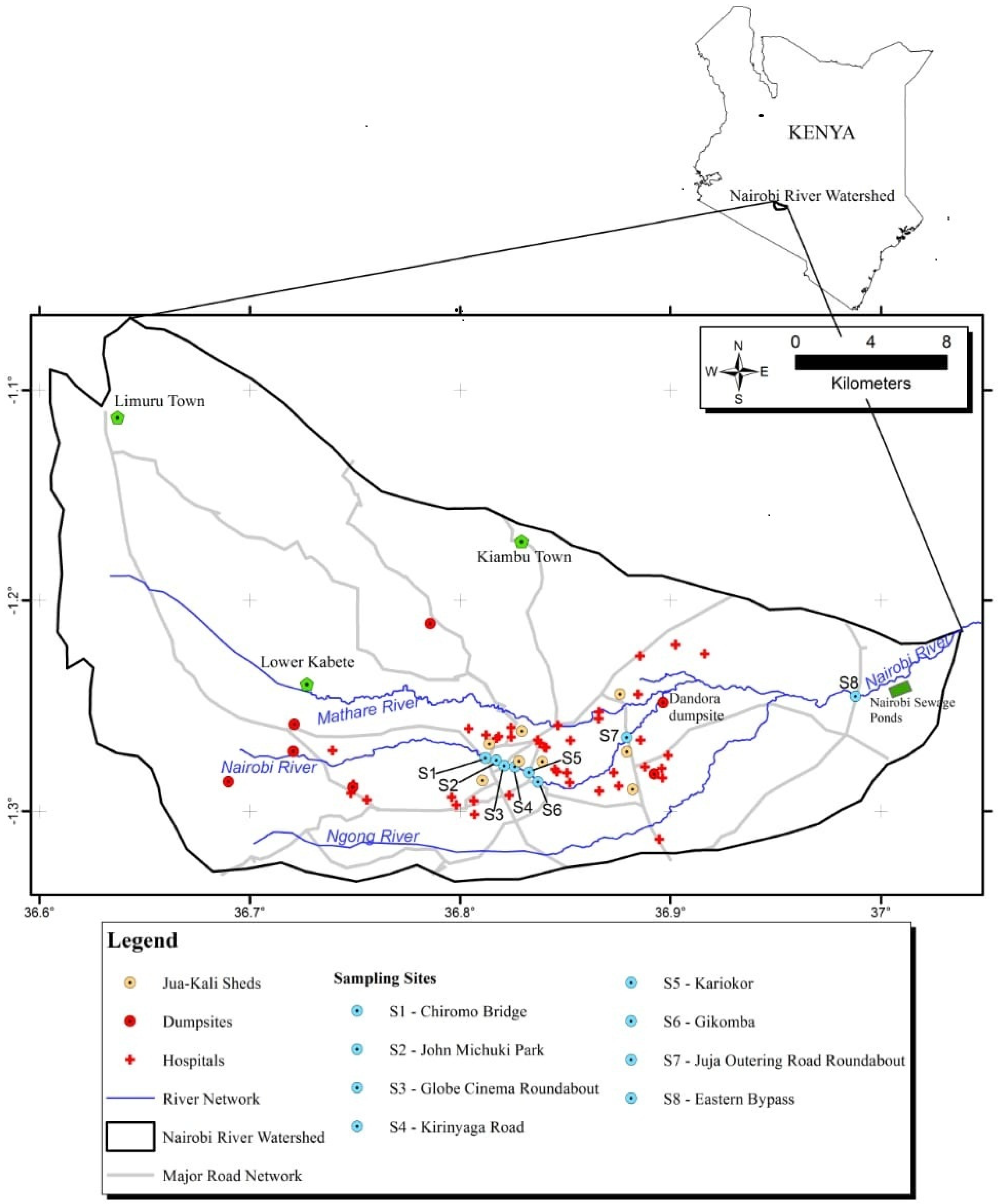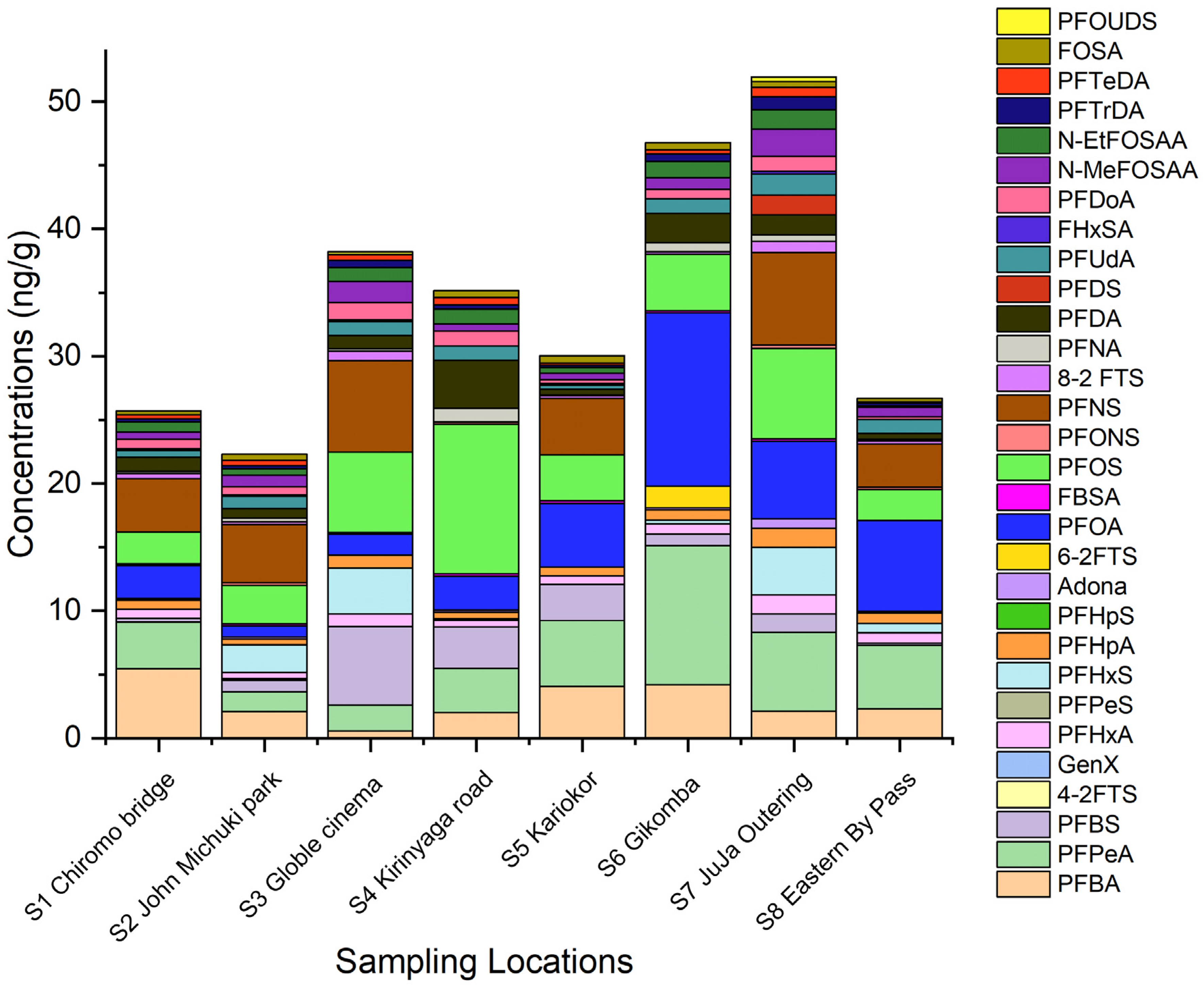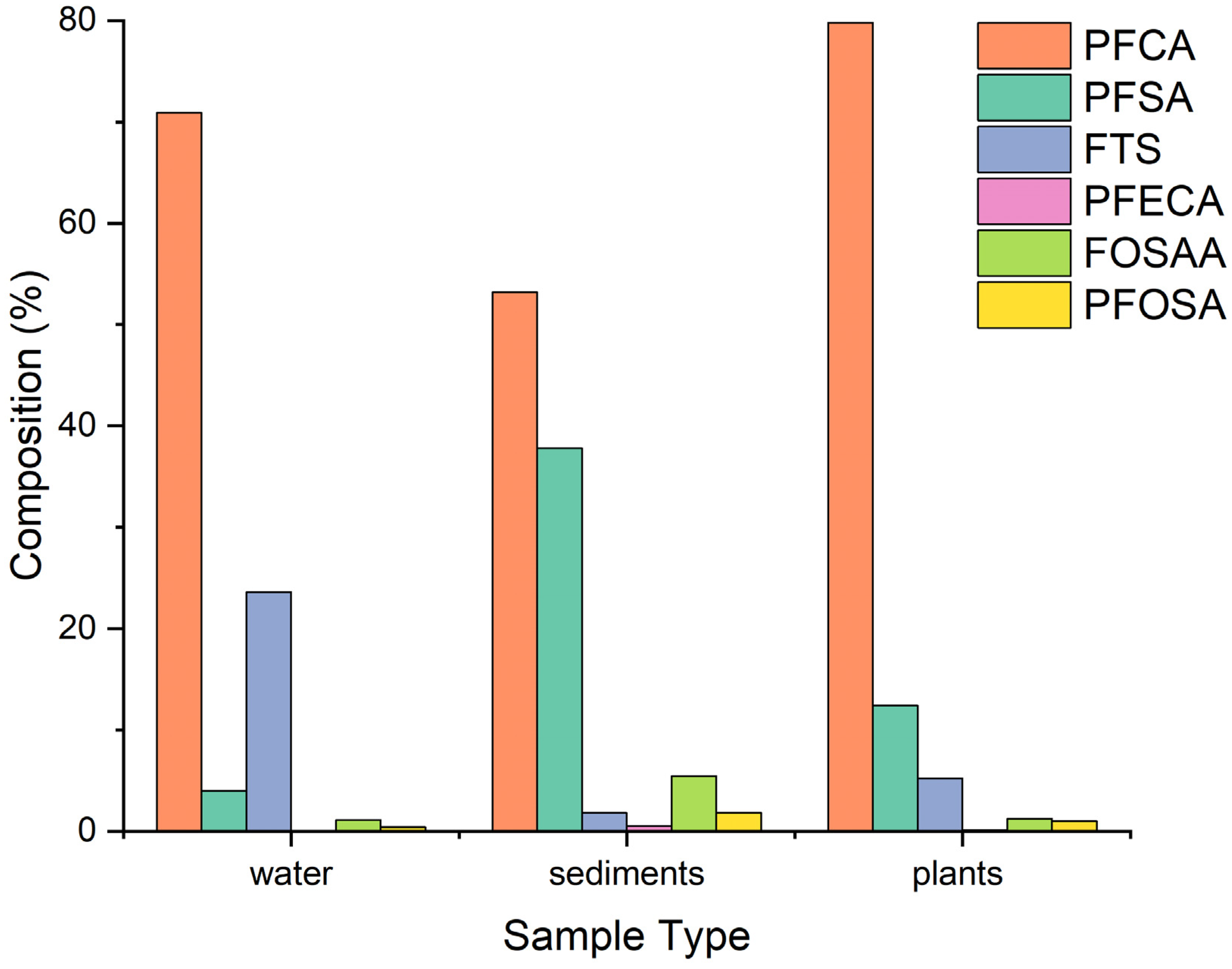Occurrence and Distribution of Per- and Polyfluoroalkyl Substances from Multi-Industry Sources to Water, Sediments and Plants along Nairobi River Basin, Kenya
Abstract
:1. Introduction
2. Materials and Methods
2.1. Description of the Study Area
2.2. Chemicals and Materials
2.3. Sample Collection
2.4. Extraction of PFAS from Water Sample
2.5. Extraction of PFAS from Sediments and Plants
2.6. Instrumental Analysis
2.7. Quality Control
2.8. PFAS Data Analysis and Statistics
3. Results and Discussion
3.1. Sediment/Water PFAS Distribution Coefficient
3.2. Comparison of PFAS Levels in Nairobi River to Other Studies in Africa
4. Conclusions
Supplementary Materials
Author Contributions
Funding
Institutional Review Board Statement
Informed Consent Statement
Data Availability Statement
Acknowledgments
Conflicts of Interest
References
- Hale, S.E.; Arp, H.P.H.; Schliebner, I.; Neumann, M. Persistent, mobile and toxic (PMT) and very persistent and very mobile (vPvM) substances pose an equivalent level of concern to persistent, bioaccumulative and toxic (PBT) and very persistent and very bioaccumulative (vPvB) substances under REACH. Environ. Sci. Eur. 2020, 32, 155. [Google Scholar] [CrossRef]
- Blake, B.E.; Fenton, S.E. Early life exposure to per- and polyfluoroalkyl substances (PFAS) and latent health outcomes: A review including the placenta as a target tissue and possible driver of peri- and postnatal effects. Toxicology 2020, 443, 152565. [Google Scholar] [CrossRef] [PubMed]
- Wielsøe, M.; Long, M.; Ghisari, M.; Bonefeld-Jørgensen, E.C. Perfluoroalkylated substances (PFAS) affect oxidative stress biomarkers in vitro. Chemosphere 2015, 129, 239–245. [Google Scholar] [CrossRef] [PubMed]
- Wang, T.; Wang, Y.; Liao, C.; Cai, Y.; Jiang, G. Perspectives on the Inclusion of Perfluorooctane Sulfonate into the Stockholm Convention on Persistent Organic Pollutants. Environ. Sci. Technol. 2009, 43, 5171–5175. [Google Scholar] [CrossRef] [PubMed] [Green Version]
- UNEP. Decision SC-9/12: Listing of Perfluorooctanoic Acid (2019), Its Salts and PFOA-Related Compounds. UN Environment (UNEP), Secretariat of the Basel, Rotterdam and Stockholm Conventions, Geneva, Switzerland. 2019. Available online: http://chm.pops.int/TheConvention/ConferenceoftheParties/Meetings/COP5/tabid/1267/mctl/ViewDetails/EventModID/870/EventID/109/xmid/4351/Default.aspx (accessed on 16 March 2022).
- Kurwadkar, S.; Dane, J.; Kanel, S.R.; Nadagouda, M.N.; Cawdrey, R.W.; Ambade, B.; Struckhoff, G.C.; Wilkin, R. Per- and polyfluoroalkyl substances in water and wastewater: A critical review of their global occurrence and distribution. Sci. Total Environ. 2021, 809, 151003. [Google Scholar] [CrossRef] [PubMed]
- Meng, L.; Song, B.; Zhong, H.; Ma, X.; Wang, Y.; Ma, D.; Lu, Y.; Gao, W.; Wang, Y.; Jiang, G. Legacy and emerging per- and polyfluoroalkyl substances (PFAS) in the Bohai Sea and its inflow rivers. Environ. Int. 2021, 156, 106735. [Google Scholar] [CrossRef]
- Qi, Y.; Huo, S.; Xi, B.; Hu, S.; Zhang, J.; He, Z. Spatial distribution and source apportionment of PFASs in surface sediments from five lake regions, China. Sci. Rep. 2016, 6, 22674. [Google Scholar] [CrossRef] [Green Version]
- De Silva, A.O.; Armitage, J.M.; Bruton, T.A.; Dassuncao, C.; Heiger-Bernays, W.; Hu, X.C.; Kärrman, A.; Kelly, B.; Ng, C.; Robuck, A.; et al. PFAS Exposure Pathways for Humans and Wildlife: A Synthesis of Current Knowledge and Key Gaps in Understanding. Environ. Toxicol. Chem. 2020, 40, 631–657. [Google Scholar] [CrossRef]
- Ssebugere, P.; Sillanpää, M.; Matovu, H.; Wang, Z.; Schramm, K.-W.; Omwoma, S.; Wanasolo, W.; Ngeno, E.C.; Odongo, S. Environmental levels and human body burdens of per- and poly-fluoroalkyl substances in Africa: A critical review. Sci. Total Environ. 2020, 739, 139913. [Google Scholar] [CrossRef]
- Shafique, U.; Schulze, S.; Slawik, C.; Böhme, A.; Paschke, A.; Schüürmann, G. Perfluoroalkyl acids in aqueous samples from Germany and Kenya. Environ. Sci. Pollut. Res. 2016, 24, 11031–11043. [Google Scholar] [CrossRef]
- Chirikona, F.; Filipovic, M.; Ooko, S.; Orata, F. Perfluoroalkyl acids in selected wastewater treatment plants and their discharge load within the Lake Victoria basin in Kenya. Environ. Monit. Assess. 2015, 187, 494. [Google Scholar] [CrossRef] [PubMed]
- Orata, F.; Quinete, N.; Werres, F.; Wilken, R.-D. Determination of Perfluorooctanoic Acid and Perfluorooctane Sulfonate in Lake Victoria Gulf Water. Bull. Environ. Contam. Toxicol. 2008, 82, 218–222. [Google Scholar] [CrossRef] [PubMed]
- Mbui, D.; Chebet, E.; Kamau, G.; Kibet, J. The state of water quality in Nairobi River, Kenya. Asian J. Res. Chem. 2016, 9, 579. [Google Scholar] [CrossRef]
- Taniyasu, S.; Kannan, K.; So, M.K.; Gulkowska, A.; Sinclair, E.; Okazawa, T.; Yamashita, N. Analysis of fluorotelomer alcohols, fluorotelomer acids, and short- and long-chain perfluorinated acids in water and biota. J. Chromatogr. A 2005, 1093, 89–97. [Google Scholar] [CrossRef] [PubMed]
- Lemos, L.; Gantiva, L.; Kaylor, C.; Sanchez, A.; Quinete, N. American oysters as bioindicators of emerging organic contaminants in Florida, United States. Sci. Total Environ. 2022, 835, 155316. [Google Scholar] [CrossRef]
- Li, X.; Fatowe, M.; Cui, D.; Quinete, N. Assessment of per- and polyfluoroalkyl substances in Biscayne Bay surface waters and tap waters from South Florida. Sci. Total Environ. 2021, 806, 150393. [Google Scholar] [CrossRef] [PubMed]
- Wang, T.; Wang, P.; Meng, J.; Liu, S.; Lu, Y.; Khim, J.S.; Giesy, J.P. A review of sources, multimedia distribution and health risks of perfluoroalkyl acids (PFAAs) in China. Chemosphere 2014, 129, 87–99. [Google Scholar] [CrossRef]
- Lin, Y.; Jiang, J.-J.; Rodenburg, L.A.; Cai, M.; Wu, Z.; Ke, H.; Chitsaz, M. Perfluoroalkyl substances in sediments from the Bering Sea to the western Arctic: Source and pathway analysis. Environ. Int. 2020, 139, 105699. [Google Scholar] [CrossRef]
- Buck, R.C.; Franklin, J.; Berger, U.; Conder, J.M.; Cousins, I.T.; De Voogt, P.; Jensen, A.A.; Kannan, K.; Mabury, S.A.; Van Leeuwen, S.P. Perfluoroalkyl and polyfluoroalkyl substances in the environment: Terminology, classification, and origins. Integr. Environ. Assess. Manag. 2011, 7, 513–541. [Google Scholar] [CrossRef]
- Higgins, C.P.; Luthy, R.G. Sorption of Perfluorinated Surfactants on Sediments. Environ. Sci. Technol. 2006, 40, 7251–7256. [Google Scholar] [CrossRef]
- Nguyen, T.M.H.; Bräunig, J.; Thompson, K.; Thompson, J.; Kabiri, S.; Navarro, D.A.; Kookana, R.S.; Grimison, C.; Barnes, C.M.; Higgins, C.P.; et al. Influences of Chemical Properties, Soil Properties, and Solution pH on Soil–Water Partitioning Coefficients of Per- and Polyfluoroalkyl Substances (PFASs). Environ. Sci. Technol. 2020, 54, 15883–15892. [Google Scholar] [CrossRef]
- Wang, F.; Shih, K. Adsorption of perfluorooctanesulfonate (PFOS) and perfluorooctanoate (PFOA) on alumina: Influence of solution pH and cations. Water Res. 2011, 45, 2925–2930. [Google Scholar] [CrossRef] [PubMed]
- Li, J.; Sun, J.; Li, P. Exposure routes, bioaccumulation and toxic effects of per- and polyfluoroalkyl substances (PFASs) on plants: A critical review. Environ. Int. 2021, 158, 106891. [Google Scholar] [CrossRef] [PubMed]
- Wang, W.; Rhodes, G.; Ge, J.; Yu, X.; Li, H. Uptake and accumulation of per- and polyfluoroalkyl substances in plants. Chemosphere 2020, 261, 127584. [Google Scholar] [CrossRef] [PubMed]
- Dinglasan-Panlilio, M.J.; Prakash, S.S.; Baker, J.E. Perfluorinated compounds in the surface waters of Puget Sound, Washington and Clayoquot and Barkley Sounds, British Columbia. Mar. Pollut. Bull. 2014, 78, 173–180. [Google Scholar] [CrossRef] [PubMed]
- Clara, M.; Gans, O.; Weiss, S.; Sanz-Escribano, D.; Scharf, S.; Scheffknecht, C. Perfluorinated alkylated substances in the aquatic environment: An Austrian case study. Water Res. 2009, 43, 4760–4768. [Google Scholar] [CrossRef]
- European Union. Directive 2013/39/EU of the European Parliament and of the Council of 12 August 2013 Amending Directives 2000/60/EC and 2008/105/EC as Regards Priority Substances in the Field of Water Policy. L. 226/1 Official Journal of the European Union. 2013. Available online: https://eur-lex.europa.eu/LexUriServ/LexUriServ.do?uri=OJ:L:2013:226:0001:0017:en:PDF (accessed on 23 March 2022).
- Zeng, Z.; Song, B.; Xiao, R.; Zeng, G.; Gong, J.; Chen, M.; Xu, P.; Zhang, P.; Shen, M.; Yi, H. Assessing the human health risks of perfluorooctane sulfonate by in vivo and in vitro studies. Environ. Int. 2019, 126, 598–610. [Google Scholar] [CrossRef]
- Joensen, U.N.; Bossi, R.; Leffers, H.; Jensen, A.A.; Skakkebæk, N.E.; Jørgensen, N. Do Perfluoroalkyl Compounds Impair Human Semen Quality? Environ. Health Perspect. 2009, 117, 923–927. [Google Scholar] [CrossRef]
- Song, X.; Tang, S.; Zhu, H.; Chen, Z.; Zang, Z.; Zhang, Y.; Niu, X.; Wang, X.; Yin, H.; Zeng, F.; et al. Biomonitoring PFAAs in blood and semen samples: Investigation of a potential link between PFAAs exposure and semen mobility in China. Environ. Int. 2018, 113, 50–54. [Google Scholar] [CrossRef]
- Eriksson, U.; Haglund, P.; Kärrman, A. Contribution of precursor compounds to the release of per- and polyfluoroalkyl substances (PFASs) from waste water treatment plants (WWTPs). J. Environ. Sci. 2017, 61, 80–90. [Google Scholar] [CrossRef]
- Ahrens, L. Polyfluoroalkyl compounds in the aquatic environment: A review of their occurrence and fate. J. Environ. Monit. 2011, 13, 20–31. [Google Scholar] [CrossRef] [PubMed]
- Zhao, P.; Xia, X.; Dong, J.; Xia, N.; Jiang, X.; Li, Y.; Zhu, Y. Short- and long-chain perfluoroalkyl substances in the water, suspended particulate matter, and surface sediment of a turbid river. Sci. Total Environ. 2016, 568, 57–65. [Google Scholar] [CrossRef] [PubMed] [Green Version]
- Scher, D.P.; Kelly, J.E.; Huset, C.A.; Barry, K.M.; Hoffbeck, R.W.; Yingling, V.L.; Messing, R.B. Occurrence of perfluoroalkyl substances (PFAS) in garden produce at homes with a history of PFAS-contaminated drinking water. Chemosphere 2018, 196, 548–555. [Google Scholar] [CrossRef] [PubMed]
- Brendel, S.; Fetter, É.; Staude, C.; Vierke, L.; Biegel-Engler, A. Short-chain perfluoroalkyl acids: Environmental concerns and a regulatory strategy under REACH. Environ. Sci. Eur. 2018, 30, 9. [Google Scholar] [CrossRef]
- Chambers, W.S.; Hopkins, J.G.; Richards, S.M. A Review of Per- and Polyfluorinated Alkyl Substance Impairment of Reproduction. Front. Toxicol. 2021, 3, 732436. [Google Scholar] [CrossRef] [PubMed]
- Vaalgamaa, S.; Vähätalo, A.V.; Perkola, N.; Huhtala, S. Photochemical reactivity of perfluorooctanoic acid (PFOA) in conditions representing surface water. Sci. Total Environ. 2011, 409, 3043–3048. [Google Scholar] [CrossRef] [PubMed]
- EPA United States Environmental Protection Agency. EPA and 3M Announce Phase out of PFOS. 2000. Available online: https://archive.epa.gov (accessed on 23 March 2022).
- Ritter, S.K. Fluorochemicals go short. Chem. Eng. News 2010, 88, 12–17. [Google Scholar] [CrossRef]
- Fagbayigbo, B.; Opeolu, B.; Fatoki, O.; Olatunji, O.; Akharame, M.; Human, I. Sorption and partitioning of perfluorooctanoic acid (PFOA) and perfluorooctane sulfonate (PFOS) onto sediments of Diep and Plankenburg river systems Western Cape, South Africa. Environ. Technol. Innov. 2021, 25, 102110. [Google Scholar] [CrossRef]
- Lee, Y.-M.; Lee, J.-Y.; Kim, M.-K.; Yang, H.; Lee, J.-E.; Son, Y.; Kho, Y.; Choi, K.; Zoh, K.-D. Concentration and distribution of per- and polyfluoroalkyl substances (PFAS) in the Asan Lake area of South Korea. J. Hazard. Mater. 2019, 381, 120909. [Google Scholar] [CrossRef]
- Zhang, Y.; Meng, W.; Guo, C.; Xu, J.; Yu, T.; Fan, W.; Li, L. Determination and partitioning behavior of perfluoroalkyl carboxylic acids and perfluorooctanesulfonate in water and sediment from Dianchi Lake, China. Chemosphere 2012, 88, 1292–1299. [Google Scholar] [CrossRef]
- Zhao, Y.; Wan, H.; Wong, M.; Wong, C.K. Partitioning behavior of perfluorinated compounds between sediment and biota in the Pearl River Delta of South China. Mar. Pollut. Bull. 2014, 83, 148–154. [Google Scholar] [CrossRef] [PubMed]
- Vierke, L.; Möller, A.; Klitzke, S. Transport of perfluoroalkyl acids in a water-saturated sediment column investigated under near-natural conditions. Environ. Pollut. 2014, 186, 7–13. [Google Scholar] [CrossRef] [PubMed]
- Yang, L.; Zhu, L.; Liu, Z. Occurrence and partition of perfluorinated compounds in water and sediment from Liao River and Taihu Lake, China. Chemosphere 2011, 83, 806–814. [Google Scholar] [CrossRef] [PubMed]
- Ahrens, L.; Xie, Z.; Ebinghaus, R. Distribution of perfluoroalkyl compounds in seawater from Northern Europe, Atlantic Ocean, and Southern Ocean. Chemosphere 2010, 78, 1011–1016. [Google Scholar] [CrossRef]
- Dalahmeh, S.; Tirgani, S.; Komakech, A.J.; Niwagaba, C.B.; Ahrens, L. Per- and polyfluoroalkyl substances (PFASs) in water, soil and plants in wetlands and agricultural areas in Kampala, Uganda. Sci. Total Environ. 2018, 631–632, 660–667. [Google Scholar] [CrossRef]
- Ololade, I. Spatial distribution of perfluorooctane sulfonate (PFOS) in major rivers in southwest Nigeria. Toxicol. Environ. Chem. 2014, 96, 1356–1365. [Google Scholar] [CrossRef]
- Groffen, T.; Wepener, V.; Malherbe, W.; Bervoets, L. Distribution of perfluorinated compounds (PFASs) in the aquatic environment of the industrially polluted Vaal River, South Africa. Sci. Total Environ. 2018, 627, 1334–1344. [Google Scholar] [CrossRef]
- Ololade, I.A.; Oladoja, N.A.; Ololade, O.O.; Oloye, F.F.; Adeola, A.; Alabi, A.B.; Ademila, O.; Adanigbo, P.; Owolabi, M.B. Geographical distribution of perfluorooctanesulfonate and perfluorooctanoate in selected rivers from Nigeria. J. Environ. Chem. Eng. 2018, 6, 4061–4069. [Google Scholar] [CrossRef]






| Sampling Point | Designation | GIS Co-Ordinates | Description of Major Activities |
|---|---|---|---|
| Chiromo Bridge/Museum Hill roundabout | S1 | −1.274697, 36.811925 | Upstream with learning institutions, offices, and motor vehicles traffic |
| John Michuki Park | S2 | −1.275753, 36.817161 | Upstream small businesses, shops, cottage industries such as welding, car repair/garage |
| Globe Cinema roundabout | S3 | −1.278397, 36.820902 | Middle stream with motor vehicles traffic, cottage industries such as welding, car repair/garage |
| Kirinyaga road | S4 | −1.279823, 36.825661 | Middle stream with numerous cottage industries such as paints, panel beating, car repair/garage, dyeing industries |
| Kariokor | S5 | −1.281559, 36.832641 | Middle stream, small businesses, plastic and rubber burning with numerous cottage industries such as paints, panel beating, car repair/garage, dyeing industries, textile and food vending, dumpsites, wastewater inlet streams |
| Gikomba | S6 | −1.286105, 36.836928 | Middle stream with numerous cottage industries such as paints, panel beating, car repair/garage, dyeing industries, textile and food vending, wastewater inlet streams |
| Juja Outering road | S7 | −1.264953, 36.879202 | Downstream with leaning institutions, hospitals, dumpsites, offices and motor vehicles traffic, residential area |
| Eastern bypass | S8 | −1.245381, 36.988022 | Downstream with leaning institutions, residential area |
| Sampling Site | PFBA | PFPeA | PFHxA | PFHpA | PFOA | PFNA | PFDA | PFUDA | PFDoA | PFTeDA | PFBS | PFOS |
|---|---|---|---|---|---|---|---|---|---|---|---|---|
| S1 | 3.4 | 3.5 | 3 | 3.2 | 3.5 | 2.7 | 3.6 | 2 | 2.8 | 2.8 | 3.8 | 4.3 |
| S2 | 3.5 | 3.7 | 3.4 | 3.5 | 3.8 | 3.6 | 4 | 1.8 | 3.2 | 3.4 | 4.7 | 4.9 |
| S3 | 2.9 | 3.6 | 3.6 | 3.6 | 3.8 | 3.1 | 4.1 | 2.6 | 3.4 | 3.1 | 5.1 | 4.9 |
| S4 | 2.6 | 2.9 | 2.3 | 2.4 | 3 | 3.9 | 3.7 | 3.4 | 3.2 | - | 3.5 | 3.9 |
| S5 | 3.7 | 4.3 | 3.7 | 3.7 | 4.4 | 2.9 | 4 | 1.5 | 2.1 | 2.8 | 5.4 | 4.9 |
| S6 | 3.7 | 4.5 | 3.4 | 3.8 | 4.9 | 4.1 | 4.7 | 1.4 | 3.2 | - | 4.4 | 5 |
| S7 | 3 | 3.5 | 3.1 | 3.1 | 3.7 | 3 | 3.9 | 4.5 | 4.6 | 3.3 | 4.9 | 6.2 |
| S8 | 3.5 | 4 | 3.5 | 3.7 | 4.6 | 3.3 | 3.7 | 2.6 | 2.6 | 2.4 | 3.5 | 4.3 |
| Mean | 3.3 | 3.8 | 3.3 | 3.4 | 4 | 3.1 | 4 | 2.5 | 3.2 | 3.3 | 3.9 | 4.9 |
| Country | Study Area | PFOA Range | PFOS Range | Most Common PFAS | Notable PFAS Source | Reference |
|---|---|---|---|---|---|---|
| Kenya | Nairobi River | 0.16–3.0 | 0.004–1.4 | PFUdA | Cottage industry | This study |
| Kenya | River Sosiani Eldoret | 1.6–8.8 | - | - | Industrial and domestic wastewater | [11] |
| Kenya | Lake Victoria Gulf | 0.4–11.7 | 0.4–2.53 | - | Industrial and urban wastewater | [13] |
| Ethiopia | Lake Tana | <0.28–0.69 | 0.055–0.22 | PFBA, PFHxA | Wastewater from Bahir Dar | [47] |
| Uganda | Lake Victoria and lake Nakivoko | 2.4 | 1.6 | PFBS | Industrial and domestic discharge | [48] |
| Nigeria | A number of rivers within the country | 0.8–2.8 | 3.9–10.1 | PFOS | Industrial, domestic, and agricultural wastewater | [49] |
| South Africa | Vaal River | 0.6–4.6 | <0 LOD–35.7 | PFOS | Mining industry and wastewater treatment plants | [50] |
| South Africa | Diep Western Cape | 1.7–314 | <LOD–183 | PFOA | Urban, industrial, and agricultural discharges | [41] |
| Pore water Nigeria | A number of rivers within the country | 4.7–11.1 (1.7) | 10.9–20.4 | PFOS | Domestic and industrial discharges | [51] |
Publisher’s Note: MDPI stays neutral with regard to jurisdictional claims in published maps and institutional affiliations. |
© 2022 by the authors. Licensee MDPI, Basel, Switzerland. This article is an open access article distributed under the terms and conditions of the Creative Commons Attribution (CC BY) license (https://creativecommons.org/licenses/by/4.0/).
Share and Cite
Chirikona, F.; Quinete, N.; Gonzalez, J.; Mutua, G.; Kimosop, S.; Orata, F. Occurrence and Distribution of Per- and Polyfluoroalkyl Substances from Multi-Industry Sources to Water, Sediments and Plants along Nairobi River Basin, Kenya. Int. J. Environ. Res. Public Health 2022, 19, 8980. https://doi.org/10.3390/ijerph19158980
Chirikona F, Quinete N, Gonzalez J, Mutua G, Kimosop S, Orata F. Occurrence and Distribution of Per- and Polyfluoroalkyl Substances from Multi-Industry Sources to Water, Sediments and Plants along Nairobi River Basin, Kenya. International Journal of Environmental Research and Public Health. 2022; 19(15):8980. https://doi.org/10.3390/ijerph19158980
Chicago/Turabian StyleChirikona, Flora, Natalia Quinete, Jesleen Gonzalez, Gershom Mutua, Selly Kimosop, and Francis Orata. 2022. "Occurrence and Distribution of Per- and Polyfluoroalkyl Substances from Multi-Industry Sources to Water, Sediments and Plants along Nairobi River Basin, Kenya" International Journal of Environmental Research and Public Health 19, no. 15: 8980. https://doi.org/10.3390/ijerph19158980
APA StyleChirikona, F., Quinete, N., Gonzalez, J., Mutua, G., Kimosop, S., & Orata, F. (2022). Occurrence and Distribution of Per- and Polyfluoroalkyl Substances from Multi-Industry Sources to Water, Sediments and Plants along Nairobi River Basin, Kenya. International Journal of Environmental Research and Public Health, 19(15), 8980. https://doi.org/10.3390/ijerph19158980







